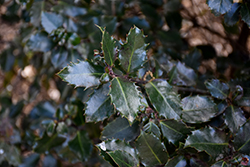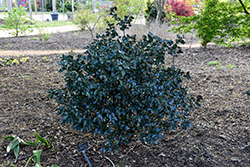Fri & Sat 8am - 8pm
Sun 8am - 7pm
Anytown, USA 12345
fax: 261.787.0463
e-mail: info@successgc.com


Plant Finder

Purple Frost Meserve Holly
Ilex x meserveae 'Purple Frost'
Height: 6 feet
Spread: 6 feet
Sunlight:
![]()
![]()
Hardiness Zone: 5a
Other Names: Blue Holly
Description:
A lovely show each spring with bright chartreuse emerging foliage on purple stems; showy red berries in winter; requires a male pollinator; excellent as a foundation plant, specimen, or hedge
Ornamental Features
Purple Frost Meserve Holly is primarily grown for its highly ornamental fruit. It features an abundance of magnificent red berries from mid fall to late winter. It has dark green evergreen foliage which emerges chartreuse in spring. The spiny oval leaves remain dark green throughout the winter. The purple branches add an interesting dimension to the landscape.
Landscape Attributes
Purple Frost Meserve Holly is a dense multi-stemmed evergreen shrub with a more or less rounded form. Its average texture blends into the landscape, but can be balanced by one or two finer or coarser trees or shrubs for an effective composition.
This is a relatively low maintenance shrub, and is best pruned in late winter once the threat of extreme cold has passed. It is a good choice for attracting birds to your yard. It has no significant negative characteristics.
Purple Frost Meserve Holly is recommended for the following landscape applications;
- Accent
- Mass Planting
- Hedges/Screening
- General Garden Use
- Container Planting
Planting & Growing
Purple Frost Meserve Holly will grow to be about 6 feet tall at maturity, with a spread of 6 feet. It tends to fill out right to the ground and therefore doesn't necessarily require facer plants in front, and is suitable for planting under power lines. It grows at a slow rate, and under ideal conditions can be expected to live for 40 years or more. This variety requires a different selection of the same species growing nearby in order to set fruit.
This shrub does best in full sun to partial shade. You may want to keep it away from hot, dry locations that receive direct afternoon sun or which get reflected sunlight, such as against the south side of a white wall. It requires an evenly moist well-drained soil for optimal growth, but will die in standing water. It is very fussy about its soil conditions and must have rich, acidic soils to ensure success, and is subject to chlorosis (yellowing) of the foliage in alkaline soils. It is somewhat tolerant of urban pollution. Consider applying a thick mulch around the root zone in winter to protect it in exposed locations or colder microclimates. This particular variety is an interspecific hybrid.
Purple Frost Meserve Holly makes a fine choice for the outdoor landscape, but it is also well-suited for use in outdoor pots and containers. Because of its height, it is often used as a 'thriller' in the 'spiller-thriller-filler' container combination; plant it near the center of the pot, surrounded by smaller plants and those that spill over the edges. It is even sizeable enough that it can be grown alone in a suitable container. Note that when grown in a container, it may not perform exactly as indicated on the tag - this is to be expected. Also note that when growing plants in outdoor containers and baskets, they may require more frequent waterings than they would in the yard or garden.

